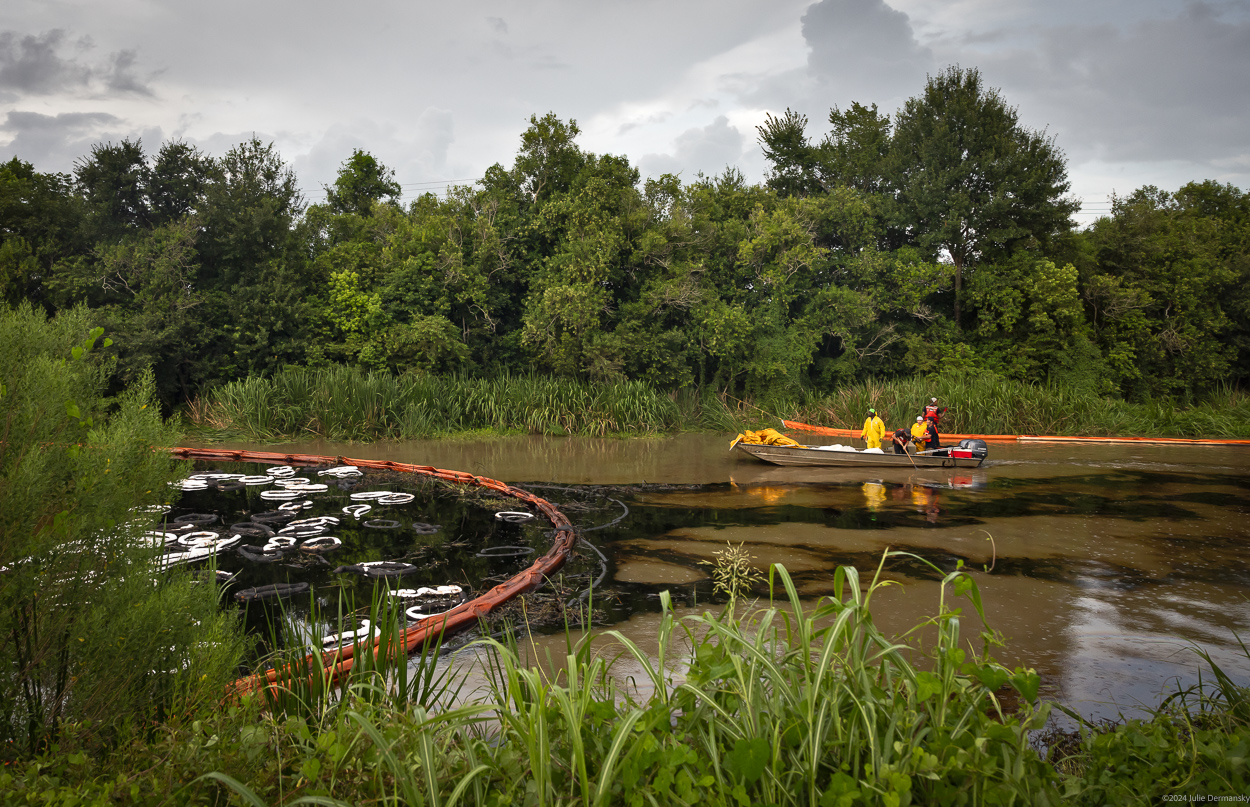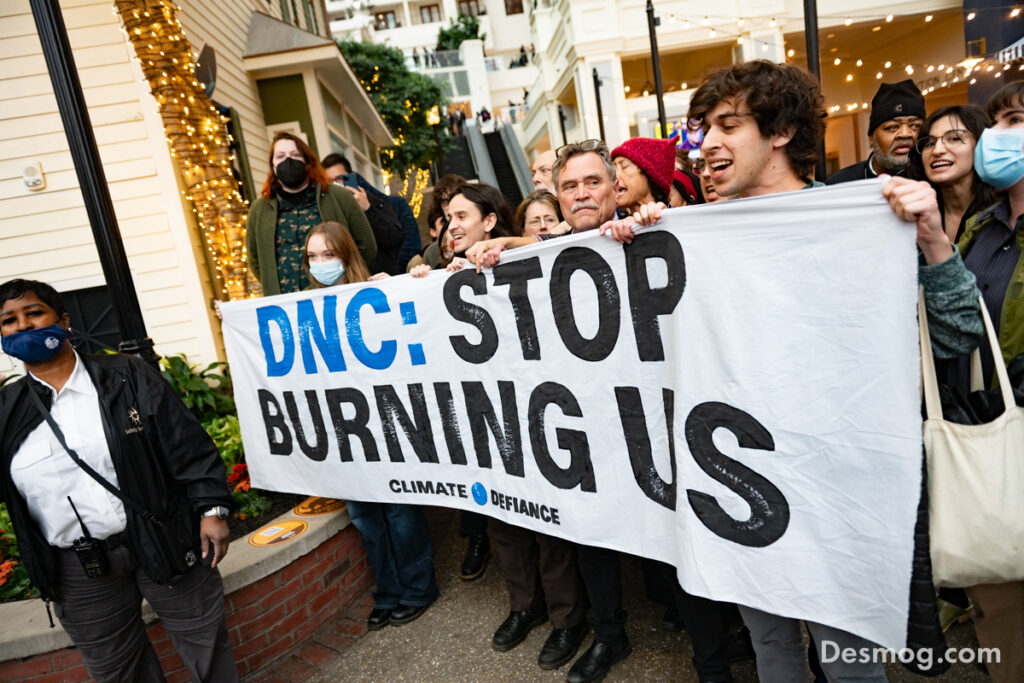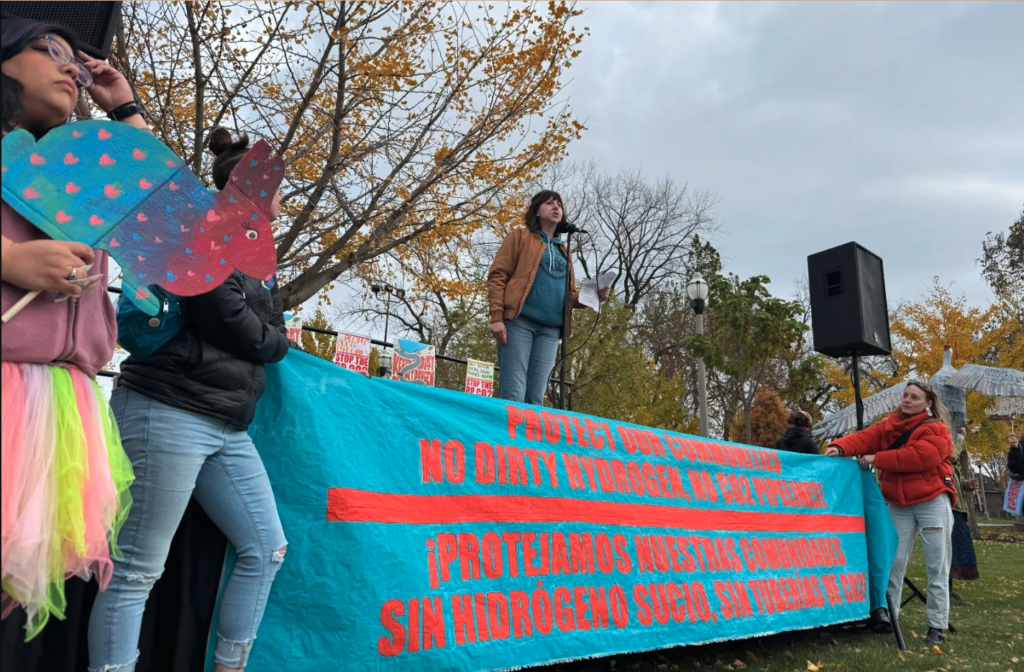The pungent smell of oil woke Gerald and Janet Crappel on the morning of Saturday, July 27. Stepping outside their home on the banks of Bayou Lafourche in Raceland, Louisiana, they spotted the fumes’ source: crude oil from Crescent Midstream’s Raceland pump station was gushing into the picturesque waterway, sparsely lined with homes and fishing boats, via a stormwater canal directly across from their home.
The oil’s fumes were thick that morning. “It choked you,” Gerald told DeSmog correspondent Julie Dermansky, who documented the incident as it unfolded. Before cleanup crews contained the spill, reportedly 34,000 gallons of crude oil, a slick stretched for eight miles, just past the area’s drinking water system.
Subscribe to our newsletter
Stay up to date with DeSmog news and alerts
According to the spill’s Unified Command of federal, state, local, and company representatives, results from “continuous air quality monitoring” were well below “actionable” levels and “indicate that there is no anticipated risk to human health” and the public water supply was safe to drink. That messaging didn’t change throughout the duration of the spill and the cleanup efforts that followed. However, a DeSmog investigation raises questions about whether the environmental monitoring conducted was robust enough to make such determinations.
The Crescent Midstream oil spill, relatively small compared to the state’s more notorious spills and other industrial accidents, represents a microcosm of the larger issues with transparency and accountability from regulators and their close relationships with, and reliance on, those responsible for environmental disasters. Time and again, this leaves those impacted by any pollution events, like those who live along Bayou Lafourche who were exposed to the fumes from the spill, wondering what was in the air and what long-term impacts, if any, the spill may have on the environment and their health.
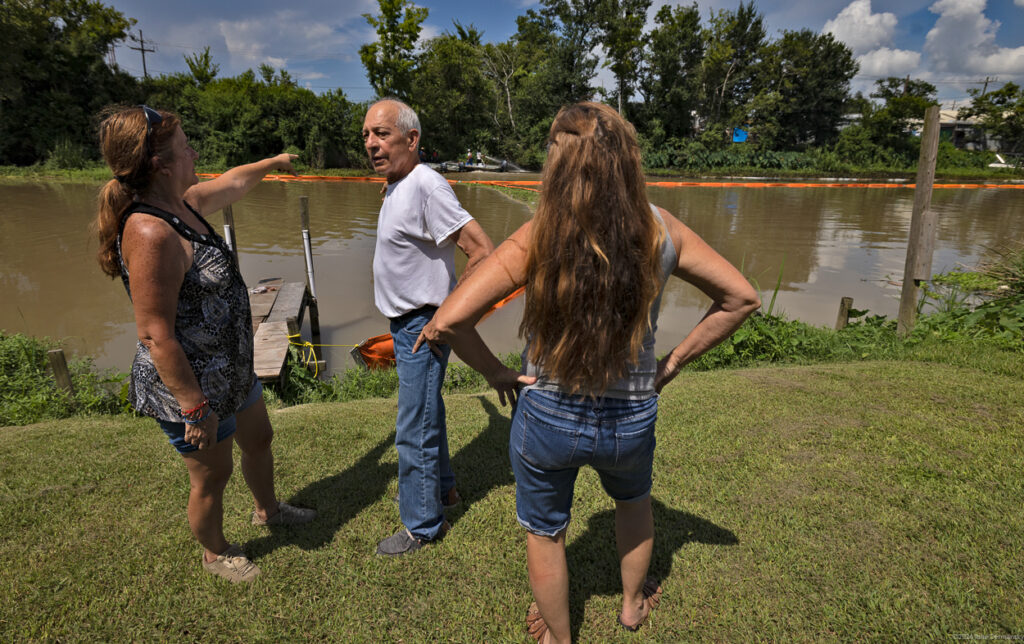
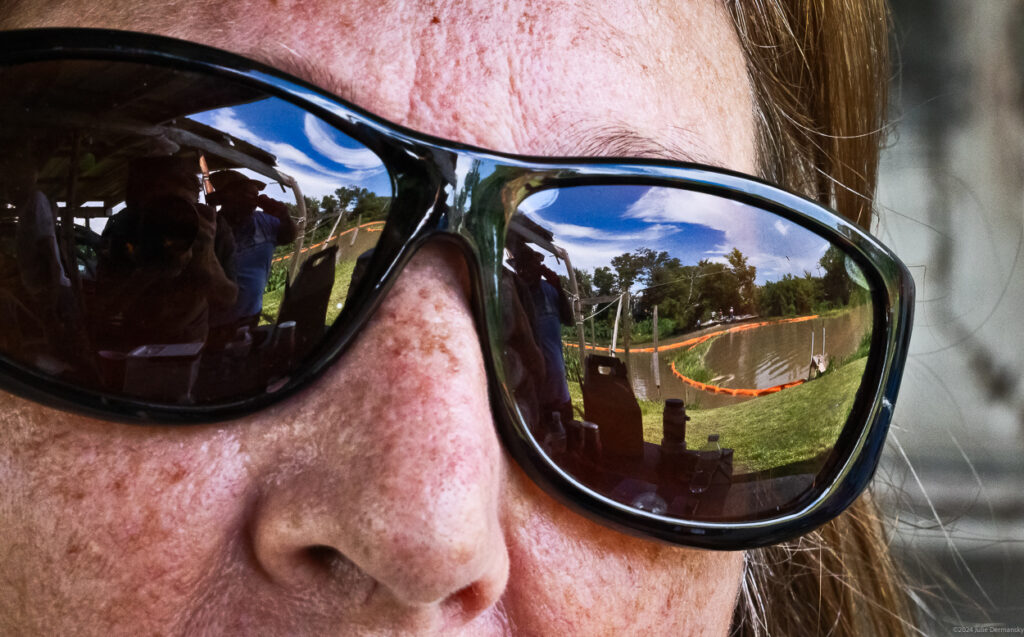
From the first day, the Unified Command sought to reassure residents that robust air monitoring indicated, despite the powerful stench in the air that sickened some, that the oil spill didn’t pose a threat to human health.
The vast majority of the reported air tests were done by a controversial contractor, CTEH, hired by Crescent Midstream, the responsible party. At a Unified Command press conference just before 3:00 p.m. on the first day of the spill, a Crescent Midstream spokesperson described deploying crews right away to monitor the air for anything that “might be unsafe for the public.” “None of them have reached the level of concern for the general public,” Crescent’s Michael Smith said of the early air readings.
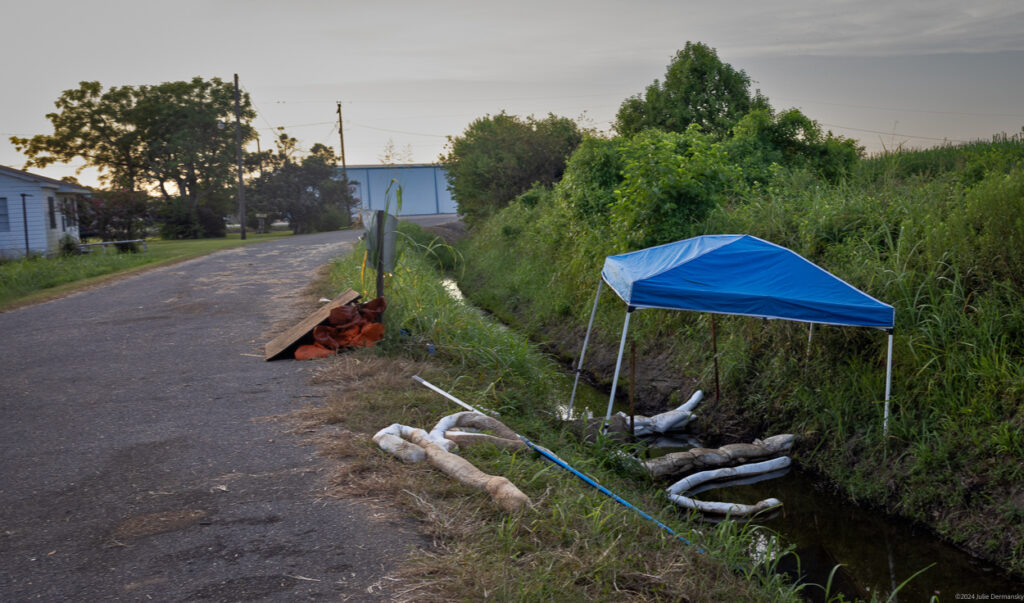
Yet the public still has no access to the air test results referenced at that press conference. The first publicly available readings reported by the Environmental Protection Agency (EPA), the lead federal agency in the Unified Command, were collected late in the day on July 27, just as stormy conditions shut down the spill response for that day.
Days later, the Unified Command directed the public and the media to an EPA StoryMap on a website devoted to the spill. Inexplicably, though it reported a couple dozen test results from the evening of the first day of the spill, the EPA reported no air test results for the day after the spill and the first date for a publicly available air test collected by Crescent Midstream’s contractor, CTEH, is over 48 hours after the oil spill, on July 29.
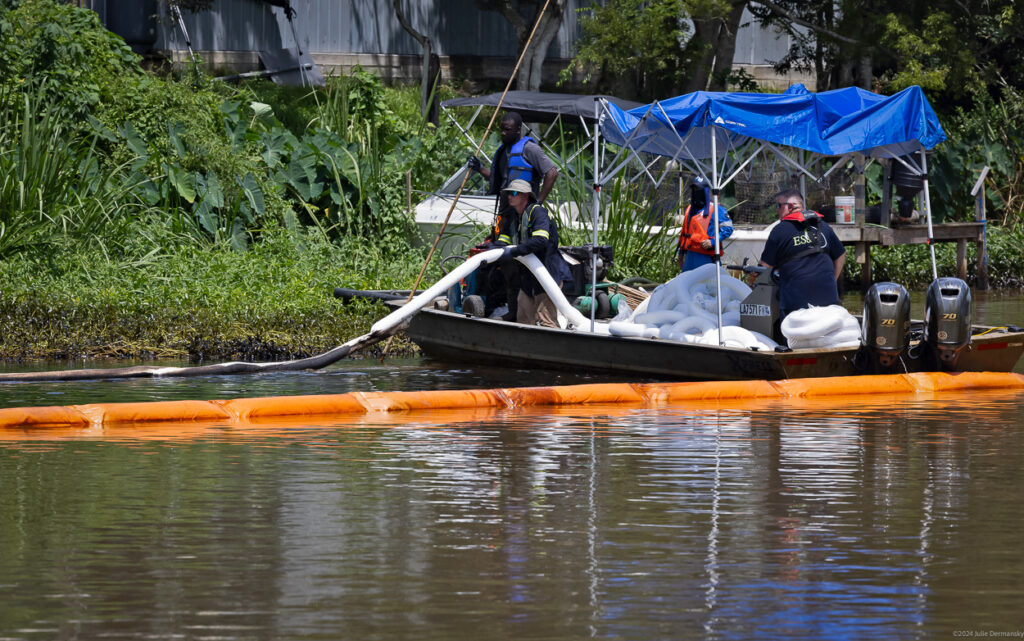
The Runaround
Dermansky arrived at the scene in the early afternoon that first day, and found oil still flowing down the bayou — contrary to initial reports about the incident that gave the impression Crescent Midstream had already contained the spill. And despite reports that no harmful pollutants in the air were detected, the fumes were strong enough to give her a headache, which is one of the typical short-term health impacts associated with exposure to benzene, a harmful chemical found in oil that quickly evaporates.
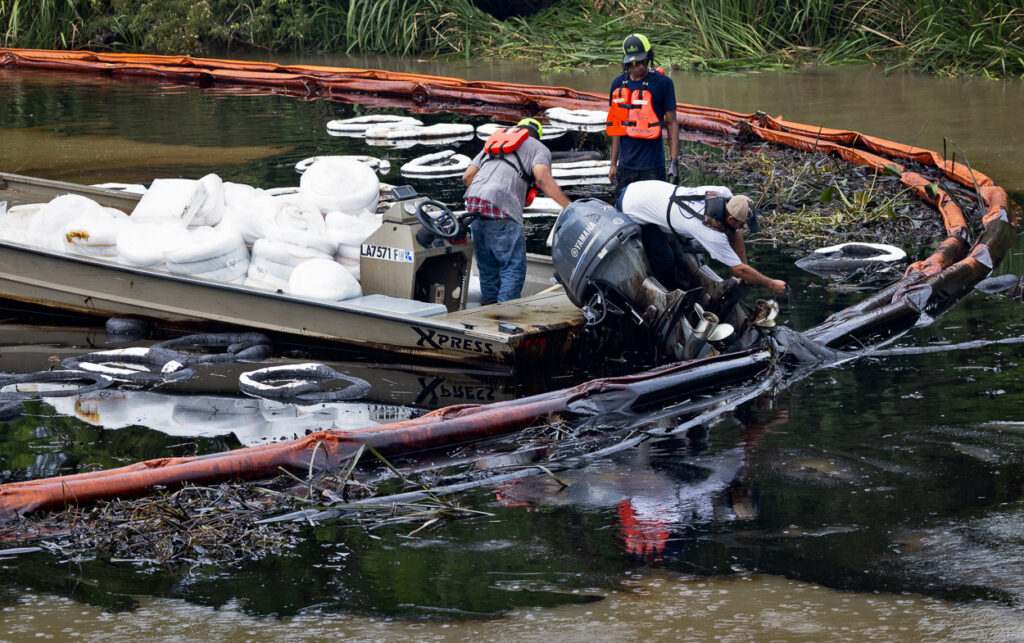
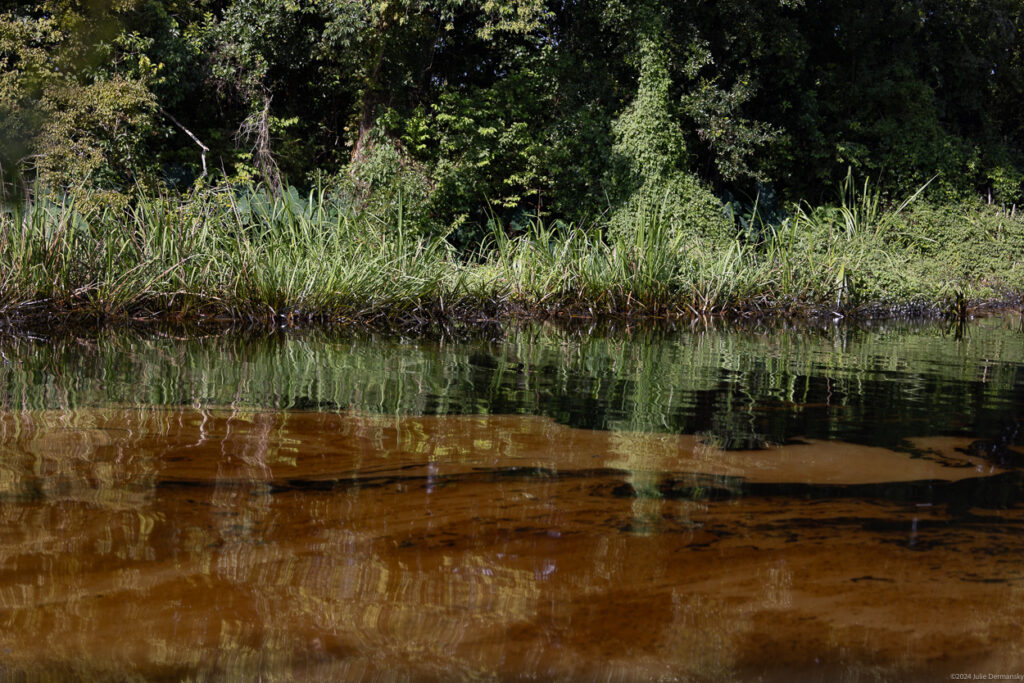
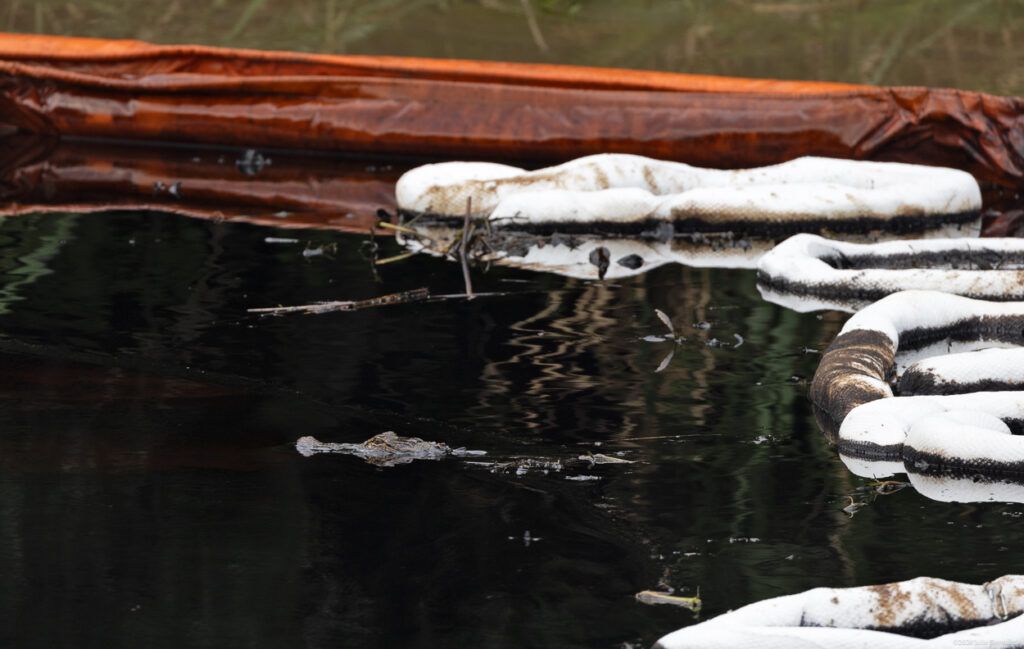
Three and a half miles downstream from the Crappels home, behind a seafood market where a containment boom successfully captured a sizable amount of oil, Dermansky crossed paths with an EPA regulator and members of a Superfund Technical Assessment Response Team (START), a third-party contractor working on behalf of the federal agency. Dermansky still questions how air monitoring efforts anywhere along the bayou where you could smell the oil didn’t detect harmful toxins in the air – especially at locations like that one, where containment boom oil trapped most of the leaked oil before it could get further downstream.
At that spot, she documented cleanup crew boats speeding up before passing over the containment boom, allowing some of the captured oil to escape and move further downstream toward the area’s water treatment facility. Though the Unified Command asserts the oil spill didn’t contaminate the area’s water treatment facility, no test results are provided on the EPA’s site dedicated to this incident.
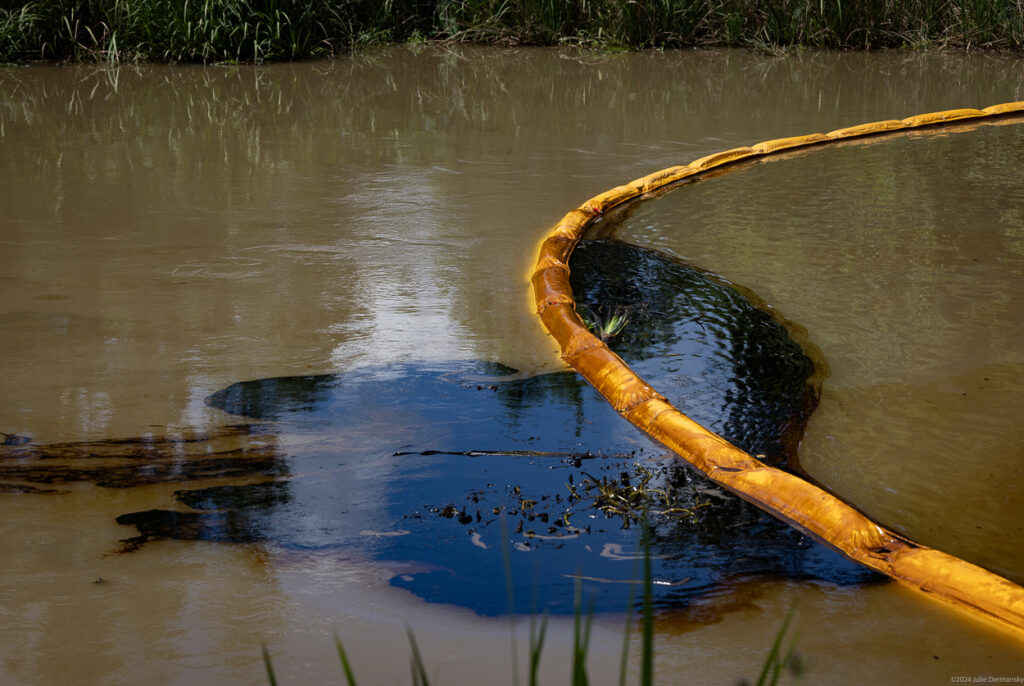
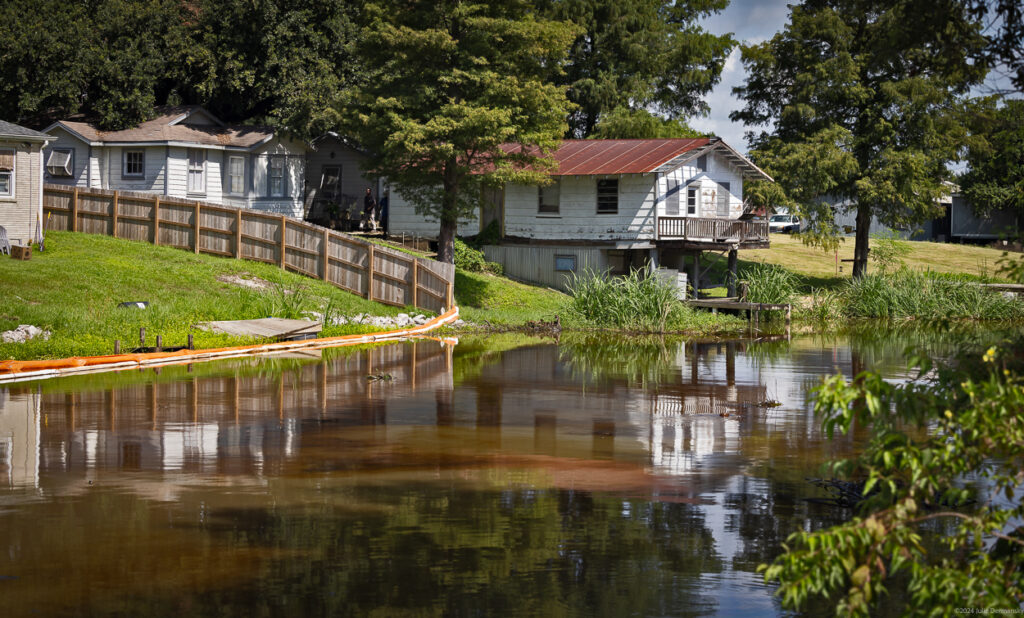
CTEH, short for the Center for Toxicology and Environmental Health, did the only stationary air monitoring at the spill site that DeSmog is aware of – a form of monitoring that gives a true picture of what is in the air versus the mobile monitoring tests conducted by the EPA and CTEH. The firm has a long track record of arriving at the scene of some of the nation’s most serious environmental catastrophes and finding little, if anything, wrong.
In 2005, CTEH collected environmental data for Murphy Oil, following a sizable oil spill in St. Bernard Parish during Hurricane Katrina, and in 2010 for BP during the largest-ever marine oil spill, in the Gulf of Mexico. In both incidents, arguably the environmental and health risks to workers and residents were greatly understated. Though this spill considerably pales in size, many residents that live along the bayou share a collective memory of how an oil spill can impact the environment and upend their lives. They were skeptical about the Unified Command’s statements that the oil spill didn’t pose a threat to their health.
The EPA’s spill website only provides information about the EPA’s own mobile handheld air monitoring tests for benzene and other volatile organic compounds and of handheld tests conducted by CTEH. It makes no mention that any stationary monitoring was conducted, though the Unified Command told DeSmog both mobile and stationary monitoring was done.
“If you can smell the crude, you can detect benzene,” environmental scientist and community advocate Wilma Subra told Desmog. That’s a point backed up by the Centers for Disease Control and Prevention (CDC), which says that most people can smell benzene only once it reaches higher concentrations that would surpass the threshold for detection – despite EPA and CTEH air monitoring efforts with mobile tools failing to detect volatile organic compounds (VOCs) in notable concentrations.
Subra said she was surprised the EPA didn’t deploy stationary air canisters, explaining that if she can smell oil but the less-sensitive handheld air monitors fail to detect chemicals emitted at the site of an oil spill, she will do the more sensitive air canister tests, which collect air samples in a fixed location over 24 hours.
“If you do not test for it, you will not find out,” she often finds herself explaining after industrial accidents, which she told DeSmog rings true for this spill too.
Further, she said, if all of the air monitoring data done by members of the Unified Command she reviewed on the EPAs site is all of the data collected, not enough data was collected in the first days following the spill to determine what was in the air.
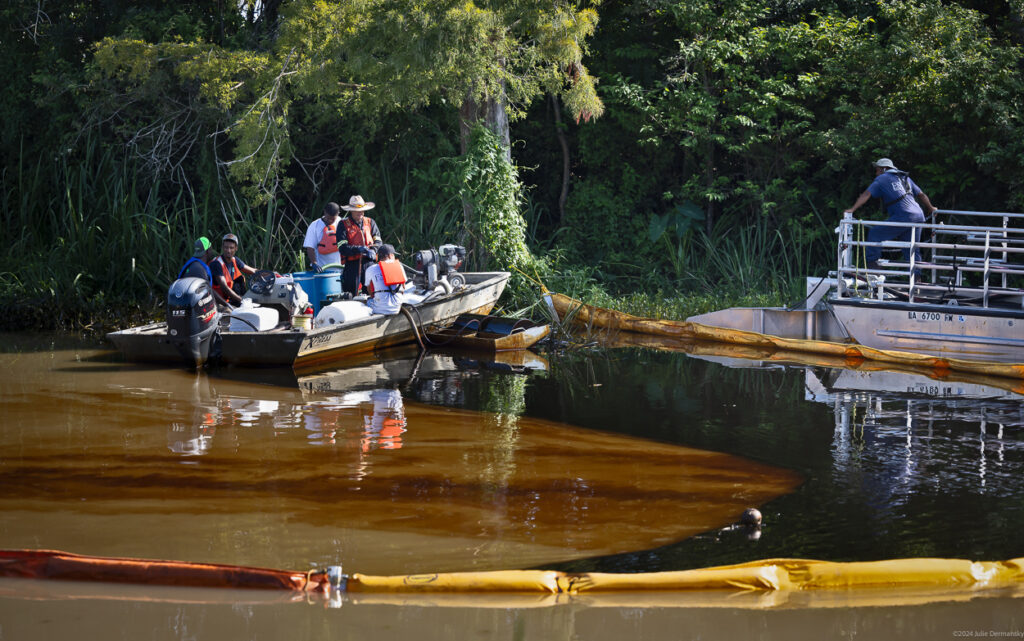
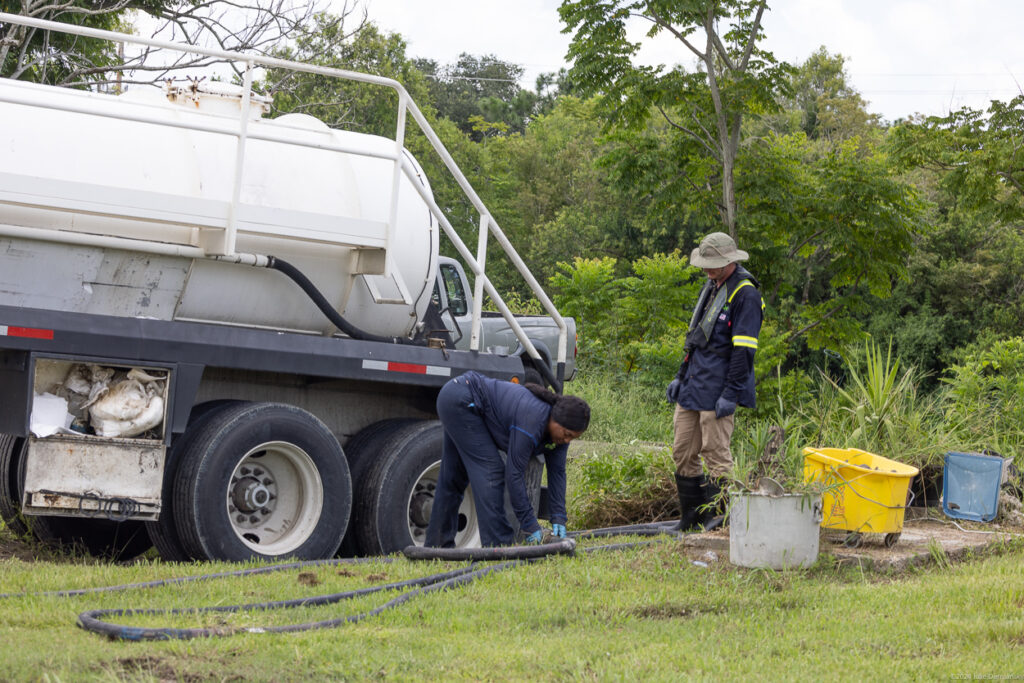
EPA Region Six press officer Joe Robledo told DeSmog in an email that because the handheld tools failed to find chemicals in the air at levels above 0.5 parts per million (ppm), further sampling wasn’t warranted.
The canisters, he added, “do not provide real time data required during oil spills to make rapid decisions for protection of public health and the environment.”
“The air sampling data was not relevant to operational decision making during the response action,” he added, “because the incident was an oil discharge to Waters of the US not a release of a hazardous [sic] substances.”
While EPA didn’t conduct this kind of sensitive air testing, CTEH did, on Crescent Midstream’s behalf and shared it with the EPA during the response, Robledo told DeSmog in an email.
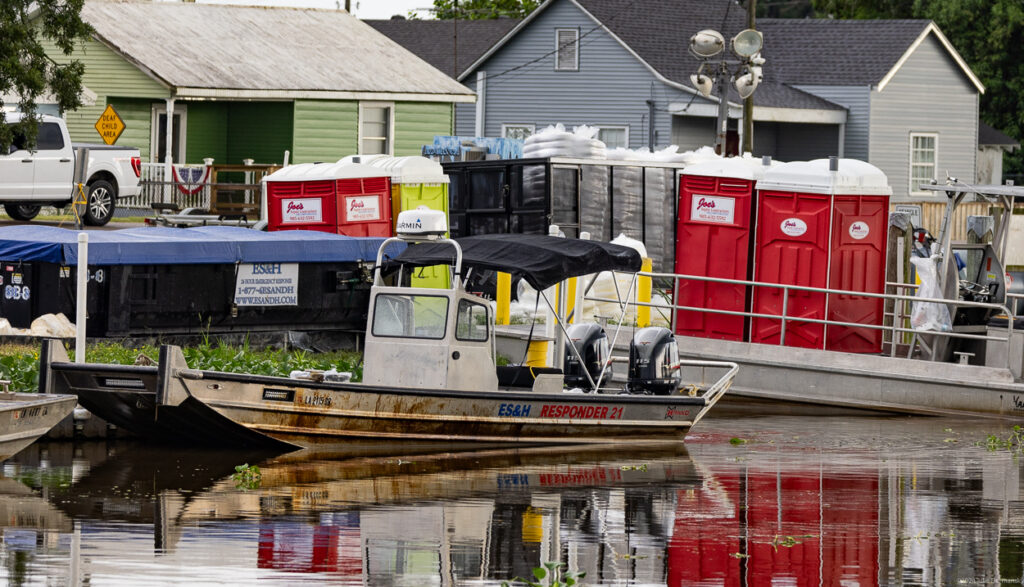
Since the EPA opted not to do stationary air testing, and CTEH’s air monitoring results on the site indicate its monitoring started on the 29th, the data you would need to determine what level of benzene and other pollutants were in the air when the fumes were the most prevalent was not collected. If you are present at an oil spill and can smell it, but your air monitoring device doesn’t detect benzene, you need to use a more sensitive air monitoring method, Subra explained. The EPA’s choice not to deploy even a single canister deprived the public of knowing exactly what was in the air, according to Subra.
It’s not clear whether or not the test results from the canister air samples CTEH collected will show high levels of benzene or other chemicals. The usefulness of that data also depends heavily on where and when CTEH’s samples were taken – information the EPA declined to provide.
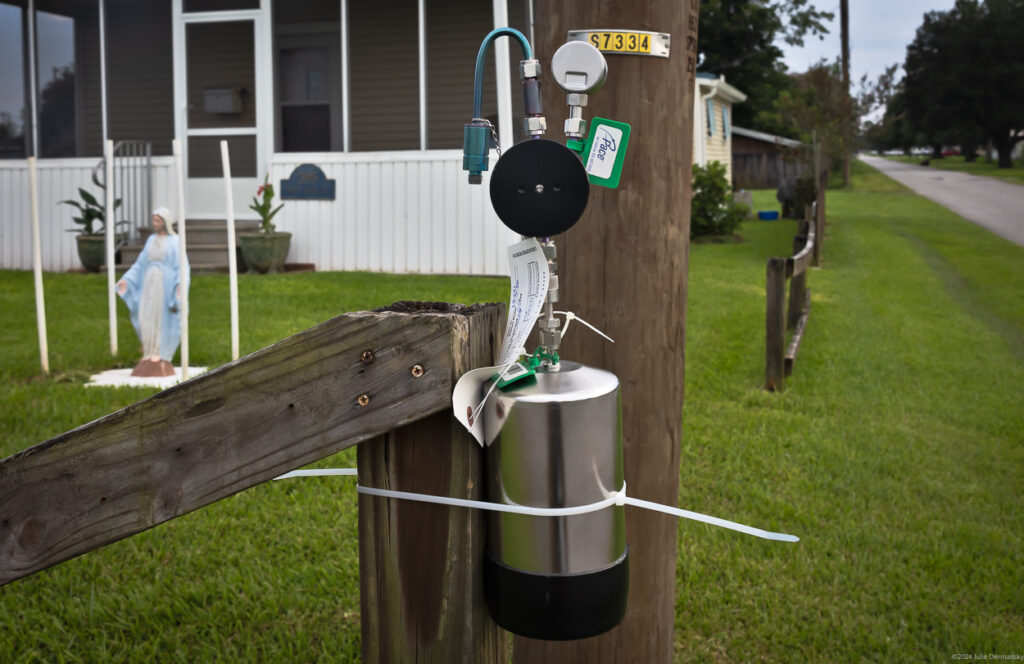
DeSmog set out to discover where and when canisters used to monitor the air quality following the spill were placed in relation to the Crappels’ home. Federal regulators and company officials all pointed to each other when asked for details on CTEH’s tests.
Though that data from CTEH’s canister tests was provided to the EPA, the agency has refused to make it public except under a legally mandatory Freedom of Information Act (FOIA) process, raising questions as to why the EPA did not include that data.
DeSmog has filed a FOIA request for the records, which remains pending. The EPA denied a request for environmental justice (EJ)-related expedited processing, saying DeSmog failed to show a “pressing need to inform the community about the Federal government activity.” The EPA includes income and disability in its EJ definition; over a quarter of Raceland’s residents have a disability and they earn nearly 20 percent less than the state median, according to the most recent census.
Yet, EPA Administrator Michael Regan and Regional Administrator Earthea Nance frequently invoke their dedication to environmental justice communities.
Crescent Midstream did not respond to questions sent by email.
DeSmog also looked for canisters during its field reporting.
A resident alerted Dermansky to an air canister they witnessed that was deployed 7.5 miles downstream from the Crappels’ home in the early evening of July 29, but she didn’t spot any near the Crappels’ home or the nearby source of the spill.
Oil in the Bayou
Unlike many small Louisiana oil spills in remote locations, which occur on a regular basis, Subra said that since this spill took place in a residential area there is no good excuse for the EPA not to have gathered more environmental data – and for that data to be disclosed to the public.
The oil’s stench was inside the Crappels’ home, as well as outside by Saturday afternoon, on the first day of the spill response, Janice Dill, Janet Crappel’s sister, told DeSmog, adding they got whiffs of the crude for weeks.
Janet Crappel told DeSmog her throat felt scratchy for days and that she experienced an upset stomach and had headaches on and off for days following the spill — all symptoms associated with exposure to benzene.
Yet, Bayou Lafourche residents were told they didn’t need to worry about health effects.
“Substances that evaporate from crude oil can be smelled at levels far below levels of concern,” an FAQ on the EPA’s dedicated site for this spill says. “Although physiological reactions such as headache and eye, nose, or throat irritation may be associated with strong odors, these responses are generally short‐lived and without long‐term effect.”
“Face masks or other respiratory protection is usually not necessary for weathered crude oil,” the FAQ notes.
Subra, however, expressed concern over the risks to those who breathed in those fumes – not just those living nearby but also anyone cleaning up the oil. “At the least, pregnant women and those with compromised immune systems should have been encouraged to leave the area,” Subra told DeSmog. She found it unconscionable that the EPA didn’t do any canister testing and would have come and deployed one herself if she had any inclination that the EPA would opt not to do any.
‘Irreparable Conflicts of Interest’
The EPA’s decision not to collect its own air canister samples in this case is not unique. State and federal regulators commonly rely on data provided by technical experts paid by the company responsible for a pollution incident, be it an oil spill or a refinery fire – a set-up public health experts have warned creates entrenched conflicts of interest.
“I believe consulting firms like CTEH are tangled in irreparable conflicts of interest,” David Michaels, former chief of the federal Occupational Safety and Health Administration (OSHA), wrote in TIME last year.
CTEH further muddies the waters of its scientific integrity by also offering to help defend its clients against legal liabilities in the wake of environmental catastrophes.
The firm has been repeatedly accused of improperly conducting air tests in particular. CTEH used the wrong tool to test the air in people’s homes for chemicals in East Palestine, a CNN report alleged, with one public health expert calling that “one of the most significant errors associated with the response” to the 2023 train catastrophe. The company was also accused of flubbing air testing during a 2019 chemical storage fire in Houston — and similarly, following the 2008 Kingston, Tennessee, coal ash waste disaster over a decade earlier. It’s been faulted for claiming toxic hydrogen sulfide from problem drywall was “not a public health concern” when later federal testing showed the opposite — with CTEH’s client among the worst offenders.
The company’s been accused of conflicts of interest often enough that a “frequently asked questions” section on its site offers an answer to the question: “How do we address the claim that CTEH never detects anything?”
Back as far as 2010, CTEH’s record was already so notorious that members of Congress wrote to BP demanding CTEH’s removal and saying BP’s decision to involve CTEH endangered spill response workers. In a 2010 letter, Reps. Peter Welsh (D-VT, now a Senator) and Rep. Lois Capps (D-CA) told BP’s then-CEO Tony Hayward that they viewed BP’s decision to involve CTEH as one that “endangers the health and safety of those trying to clean up [BP’s] mess.”
Yet, by design, the companies responsible for environmental disasters, such as BP and Crescent Midstream, and their contractors including CTEH, have central roles in the Unified Command, gathering environmental and public health data as part of the response that could put them on the hook for legal damages. As the former OSHA chief wrote, “There is no question that being paid by a polluter changes a scientist’s motivations, and thus the way they reason and work — including how they measure exposure and interpret the results.”
The Crescent Midstream spill demonstrates how environmental regulators’ highly touted commitment to transparency can fall apart when it comes into conflict with perpetrators’ desire for secrecy following environmental disasters.
Further adding to the blurriness between regulator and perpetrator, in this spill’s immediate aftermath, CTEH was presented as acting “on behalf” of the Unified Command, with EPA calling CTEH their “approved contractor” in emails to DeSmog.
But several weeks after the spill was over, EPA distanced itself from CTEH, writing that the testing company was not hired by the Unified Command, and that EPA “does not review and approve who the Responsible Party hires or gets into a contract with.”
A String of Failures
Crescent Midstream, founded in 2012, has a history of over a dozen spills and other incidents in Louisiana and the Gulf of Mexico over the past decade, federal records show.
The latest spill, documents from the Pipeline and Hazardous Materials Safety Administration’s (PHMSA) preliminary investigation suggest, may have involved more than the simple “operator error” the company attributed the spill to in early news reports, instead involving risky and potentially illegal decisions by the company.
Before the spill, Crescent Midstream had pulled an overflow tank out of service for inspection at their Raceland pump station, replacing that specialized tank with two small spares that didn’t have basic required safeguards.
Its improvised set up was repeatedly pushed beyond its capabilities in the days before the spill, PHMSA’s preliminary findings show.
Making matters worse, a fail-safe valve was left open, allowing the spilled oil to breach the site and flow into Bayou Lafourche.
“As a result of the crude oil release,” PHMSA wrote in its corrective order, “Bayou Lafourche, nearby residents, wildlife, and vegetation have been affected.” The agency separately estimated the spill caused over $12 million in damage.
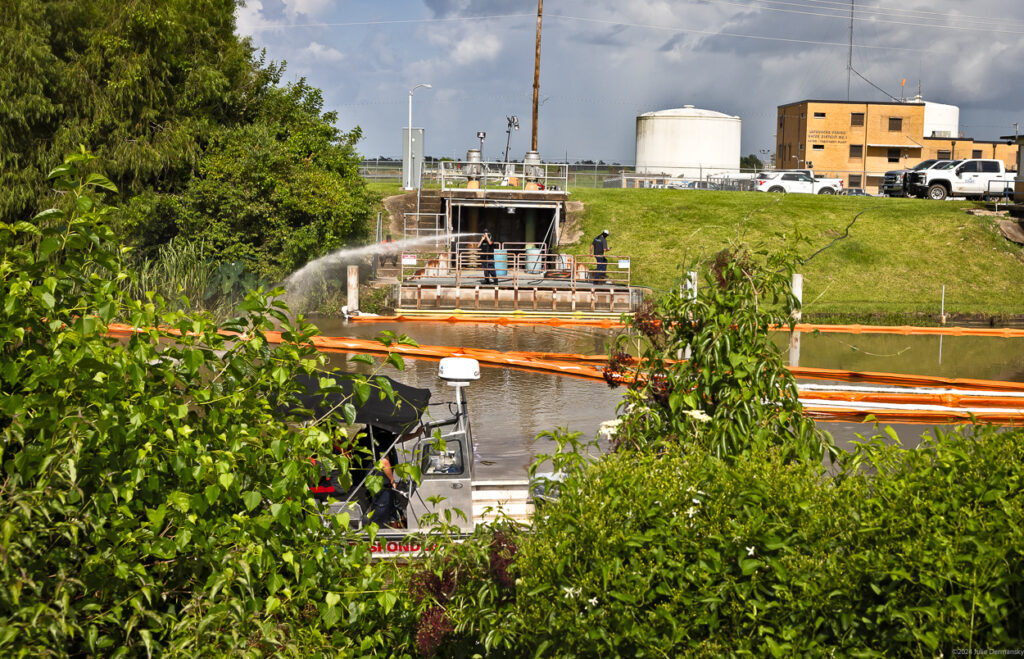
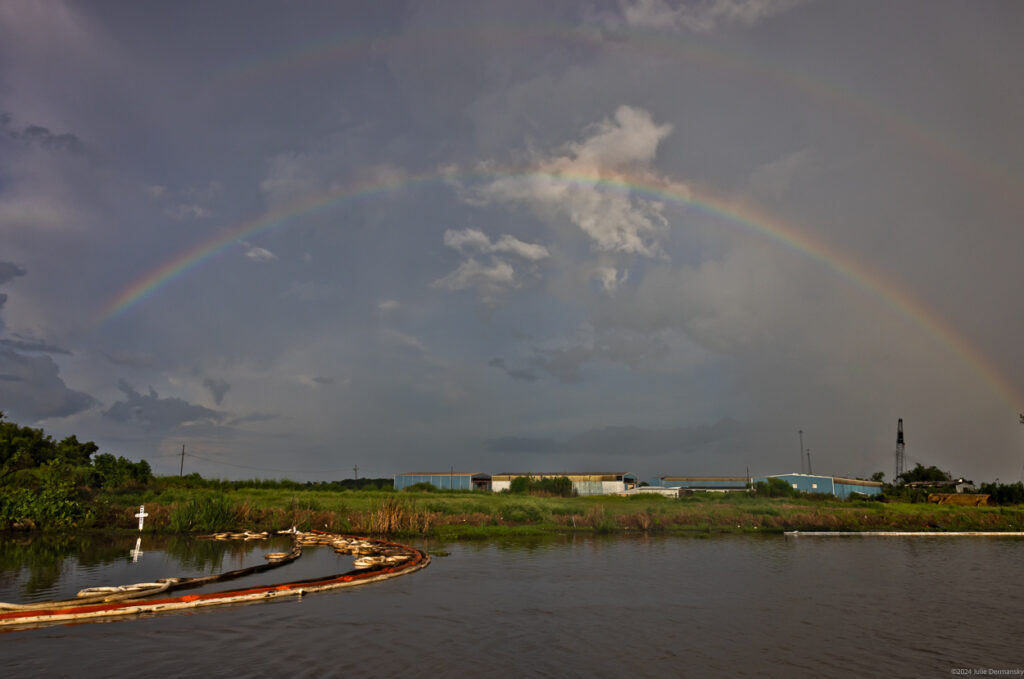
On August 7, Janet Crappel told DeSmog the fumes from the spill were still noticeable from time to time, and fish that were once bountiful in the bayou before the spill became scarce. And on Sept. 23 a new absorbent boom was put back in place across across from her home for the first time since it was picked up just before Hurricane Francine hit.
She looked for information as to why a couple weeks after the hurricane, workers felt a need to put the boom back, but found nothing about it posted on the parish website. Crappel still smells the oil occasionally and has concerns that the bayou will never be the same. She told DeSmog that a complaint her sister, Janice Dill, made to a number provided by the Unified Command for residents to report damage still hadn’t been returned. Dill asked the woman who took her report what company the woman works for — and was stunned when she was told, “I cannot disclose that.”
Subscribe to our newsletter
Stay up to date with DeSmog news and alerts


